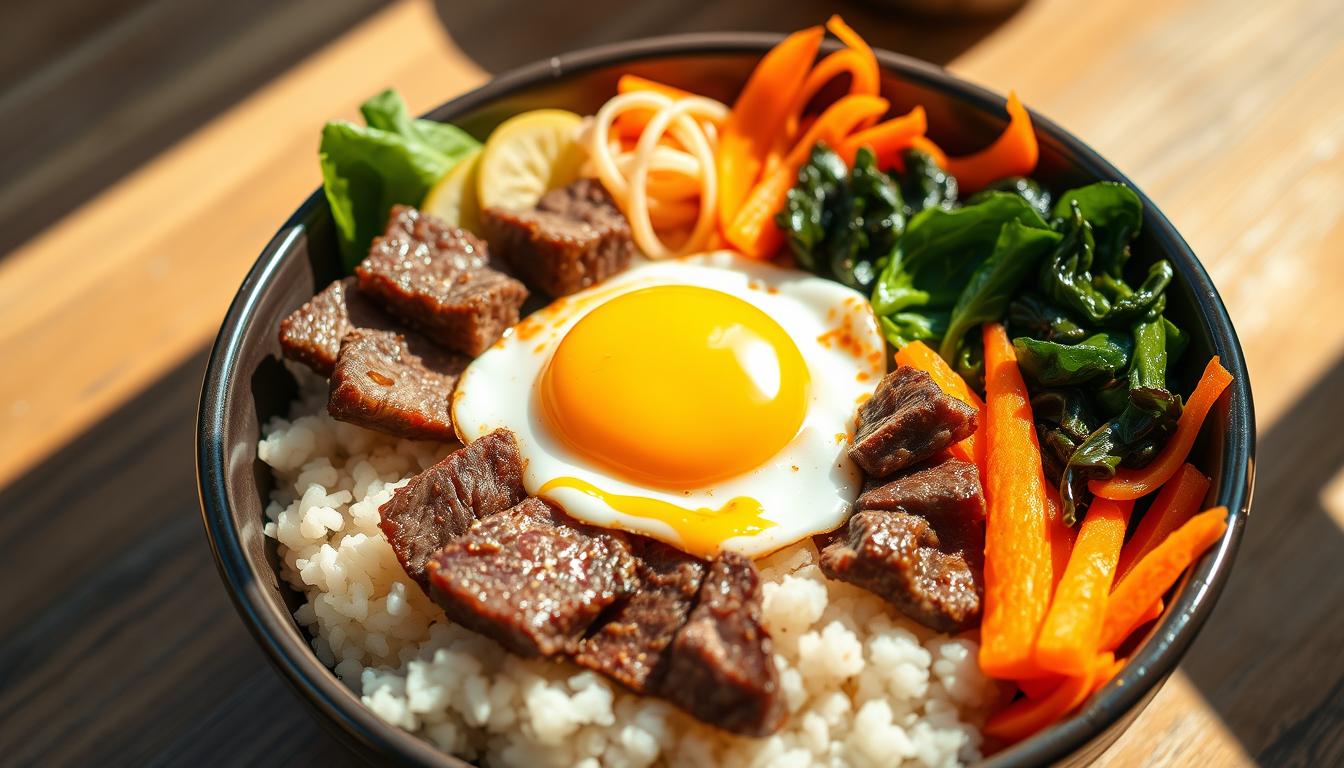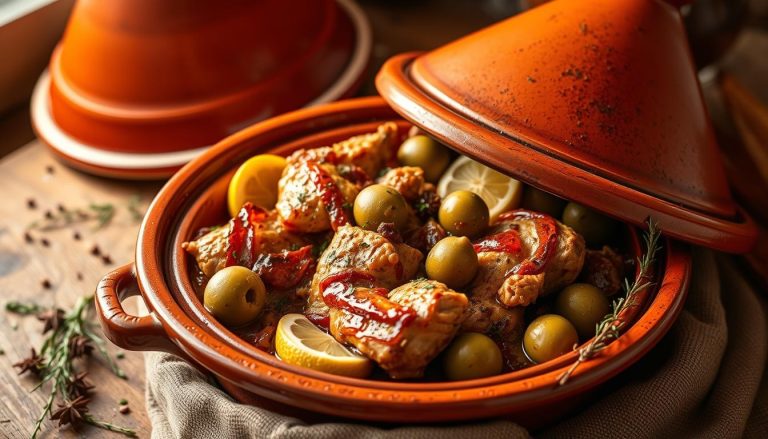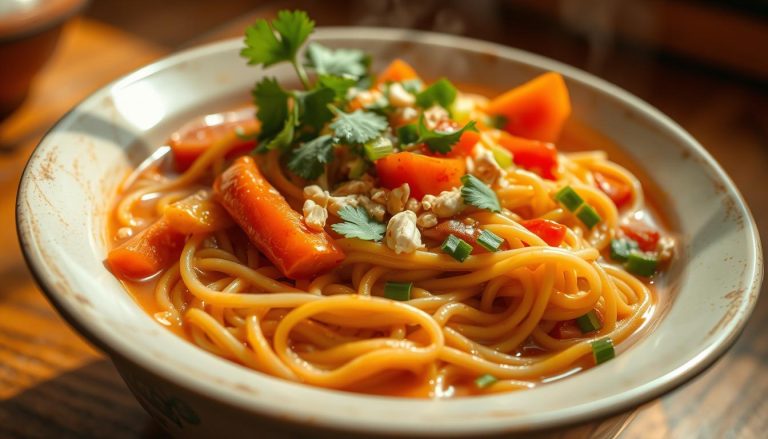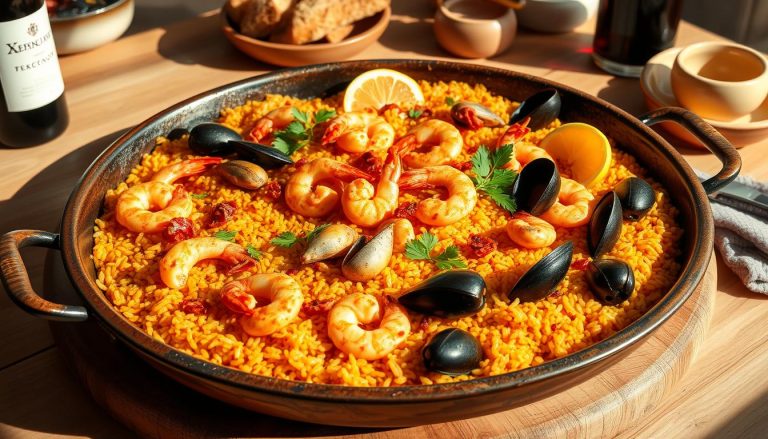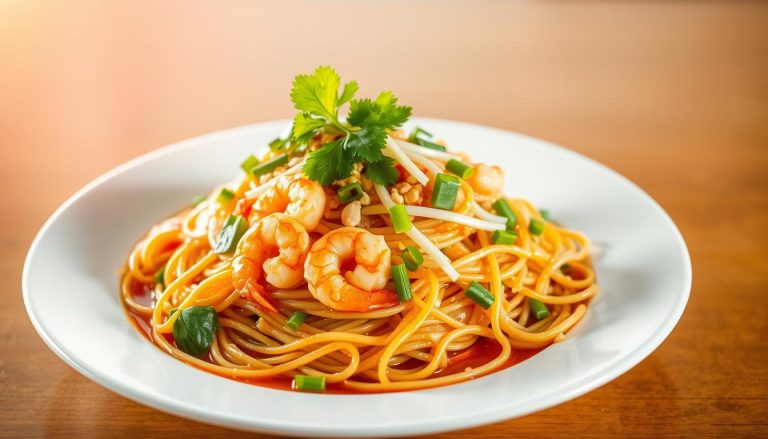Irresistible Korean Beef and Veggie Bibimbap Coréen
Craving a dish that’s both flavorful and healthy? Look no further than this authentic Korean recipe that combines marinated beef, fresh vegetables, and perfectly cooked rice. Known for its vibrant colors and rich flavors, this dish is a staple in Korean cuisine and a favorite for food lovers everywhere.
What makes this recipe special is its simplicity and versatility. You can customize it with your favorite ingredients, making it a go-to meal for any occasion. From the savory marinated beef to the crisp carrots and tender spinach, every bite is a burst of flavor.
This recipe stays true to traditional methods, ensuring an authentic taste. Whether you’re new to Korean cooking or a seasoned pro, you’ll find this dish easy to prepare and impossible to resist. Ready to dive in? Let’s get started!
Key Takeaways
- Authentic Korean recipe with marinated beef and fresh vegetables.
- Customizable with your favorite ingredients for a personalized touch.
- Healthy and flavorful, perfect for any meal.
- Uses traditional cooking methods for an authentic taste.
- Easy to prepare, even for beginners in Korean cuisine.
Exploring Authentic Flavors and Essential Ingredients
Discover the heart of Korean cuisine with its vibrant ingredients and bold flavors. Each component plays a crucial role in creating a dish that’s both balanced and delicious. From the tender beef to the crisp vegetables, every element adds its unique touch.
Key Ingredients and Their Roles
The foundation of this dish lies in its fresh, high-quality ingredients. Short-grain rice is essential, providing a sticky texture that holds everything together. Julienned carrots add a sweet crunch, while blanched spinach and bean sprouts bring a tender, earthy flavor.
For the protein, thinly sliced beef is marinated to perfection. The marinade, often made with soy sauce, garlic, and a touch of sugar, infuses the meat with savory and slightly sweet notes. A fried œuf on top adds richness, tying all the flavors together.
Marinades, Sauces, and Rice Selection
The marinade is a key player in this recipe. It not only tenderizes the beef but also enhances its flavor. Ingredients like sesame oil and seeds add a nutty aroma, while gochujang (Korean chili paste) brings a spicy kick.
When it comes to rice, opt for short-grain varieties. They have the perfect stickiness to hold the dish together. Cook the rice with a pinch of salt for added flavor.
Finally, don’t forget the sauces. A drizzle of sesame oil and a sprinkle of sesame seeds can elevate the dish, adding depth and complexity to every bite.
A Step-by-Step Preparation Guide
Ready to bring the flavors of Korea to your kitchen? Let’s dive into the step-by-step process. This guide will walk you through prepping the légumes and boeuf, cooking techniques, and timing tips for a perfect result.
Prepping the Vegetables and Meat
Start by gathering tous ingrédients. Thinly slice the beef and marinate it with soy sauce, garlic, and a touch of sugar. This marinade will tenderize the meat and infuse it with flavor.
Next, prepare the vegetables. Julienne the carotte and slice the champignon. Blanch the spinach in boiling eau for 1 minute, then season with sel and poivre. These steps ensure each component retains its texture and taste.
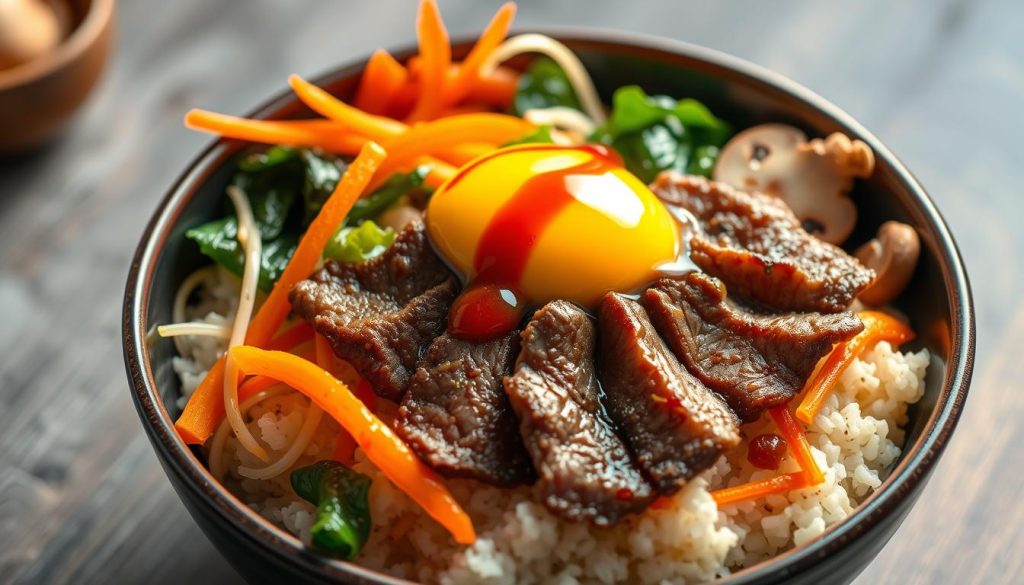
Cooking Techniques and Timing
Heat a poêle with a drizzle of huile sésame. Sauté the beef for 2-3 minutes until browned. Add the onions and cook until tender. Separately, lightly fry the œuf for a rich topping.
Cook the riz with a pinch of salt for added flavor. Assemble the dish by placing the rice in a bowl, arranging the vegetables and beef on top, and adding the fried egg. Drizzle with sauce and sprinkle with sésame seeds for a finishing touch.
This plat is a celebration of cuisine at its finest. Follow these steps, and you’ll have a dish that’s as beautiful as it is delicious.
Mastering Bibimbap Coréen aux Légumes et Bœuf Mariné
Unlock the secrets of authentic Korean cooking with this traditional dish. The recette is more than just a meal; it’s a celebration of flavors and textures that have been perfected over generations. From the crispy riz to the tender boeuf, every element plays a crucial role in creating a dish that’s both balanced and delicious.
Understanding the Traditional Methods
Traditional bibimbap is known for its vibrant presentation and layered ingredients. The dish is often served in a pre-heated dolsot (stone bowl), which creates a signature crispy rice crust. This method not only enhances the texture but also keeps the dish warm throughout the meal.
Layering is key to achieving the perfect balance of flavors. Start with a base of cooked riz, then add marinated boeuf, sautéed légumes, and a fried egg. The heat from the bowl caramelizes the rice, adding a delightful crunch to every bite.
The Role of Sauces and Seasonings
Sauces and seasonings are essential for bringing out the dish’s rich flavors. A blend of soy sauce, sésame oil, and a touch of sugar creates a savory marinade for the beef. For added depth, drizzle huile sésame and sprinkle graine over the finished dish.
Gochujang, a Korean chili paste, adds a spicy kick that complements the other ingredients. Adjust the amount to suit your taste, ensuring a harmonious blend of saveur in every bite.
Marinating the Beef
Marinating the beef is a crucial step in this préparation. The combination of soy sauce, sésame oil, and sugar tenderizes the meat and infuses it with flavor. Allow the beef to marinate for at least 30 minutes to achieve the best results.
Practical Alternatives
If you don’t have a traditional dolsot, a cast iron poêle can be a great alternative. Preheat the pan thoroughly to mimic the stone bowl’s effect, creating that coveted crispy rice crust. This method ensures you can enjoy the dish’s authentic texture without specialized cookware.
By mastering these traditional techniques, you can bring the authentic flavors of Korean cuisine to your kitchen. Whether you’re a seasoned cook or a beginner, this dish is sure to impress with its rich history and vibrant taste.
Tips, Tricks, and Serving Suggestions
Looking to elevate your Korean cooking game? Here’s how to perfect this dish. Whether you’re using traditional tools or modern alternatives, these tips will help you create a meal that’s both delicious and visually stunning.
Using a Dolsot or Alternative Cookware
A traditional dolsot (stone bowl) is ideal for achieving that crispy riz crust. If you don’t have one, a cast iron poêle works just as well. Preheat it thoroughly to mimic the dolsot’s effect. This ensures your rice stays warm and crispy while you mix in the ingredients.

Creative Serving Ideas and Accompaniments
Arrange the ingredients artfully in the bowl for a vibrant presentation. Pair your dish with banchan like kimchi or pickled légumes for added flavor. A drizzle of huile sésame and a sprinkle of sesame seeds can elevate the dish even further.
To retain the crispy texture of the rice, mix the ingredients gently. Adjust the sauce level to suit your spice preference. A little gochujang goes a long way, so start with a small amount and add more as needed.
For proper serving, keep the dish warm by using preheated bowls or plates. Store extra ingredients separately for quick reassembly the next day. This ensures your meal stays fresh and flavorful.
With these tips, you’ll create a dish that’s as beautiful as it is delicious. Enjoy the process and savor every bite!
Conclusion
Bring the vibrant flavors of Korea to your table with this easy-to-make dish. Its combination of tender boeuf, crisp légumes, and perfectly cooked riz creates a meal that’s both satisfying and nutritious. The dish’s simplicity and versatility make it a go-to recipe for any occasion.
By following traditional techniques, like marinating the beef and using huile sésame, you can achieve an authentic taste. Experiment with ingredient variations, such as adding champignon or adjusting the sauce to suit your preference. The result is a dish that’s as beautiful as it is delicious.
We encourage you to try this recipe and make it your own. Share your creations and feedback with friends and family. This dish is a perfect blend of tradition and modern convenience, offering a taste of Korean cuisine that’s sure to impress. Happy cooking!
FAQ
What are the key ingredients for making this dish?
The essential ingredients include rice, beef, sesame oil, soy sauce, carrots, spinach, mushrooms, and sesame seeds. Each component adds unique flavor and texture to the dish.
How do I prepare the beef marinade?
Mix soy sauce, sesame oil, garlic, sugar, and a pinch of pepper in a bowl. Add thinly sliced beef and let it marinate for at least 15 minutes for maximum flavor.
Can I use other vegetables in this recipe?
Absolutely! Feel free to add zucchini, onion, or bean sprouts. The dish is versatile, so you can customize it with your favorite veggies.
What type of rice works best for this dish?
Short-grain rice is ideal because it’s sticky and holds the dish together well. Cook it slightly firm for the perfect texture.
How do I achieve the crispy rice layer at the bottom?
Use a dolsot (stone bowl) or a non-stick skillet. Cook the rice on medium-high heat until it forms a golden, crispy crust.
Can I make this dish vegetarian?
Yes! Simply skip the beef and add more vegetables or tofu. Use a vegetarian-friendly sauce for seasoning.
What’s the best way to serve this dish?
Serve it in a bowl with all the ingredients arranged neatly. Top with a fried egg and sprinkle sesame seeds for extra flavor and presentation.
How long does it take to prepare this dish?
Preparation takes about 30 minutes, including chopping and marinating. Cooking time is around 15 minutes, making it a quick and satisfying meal.

